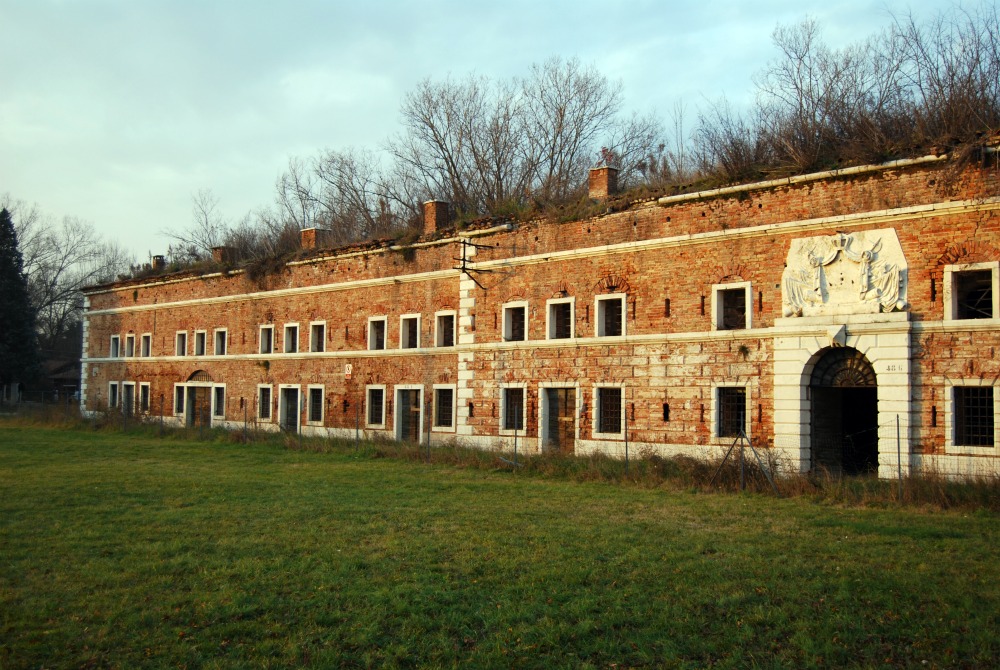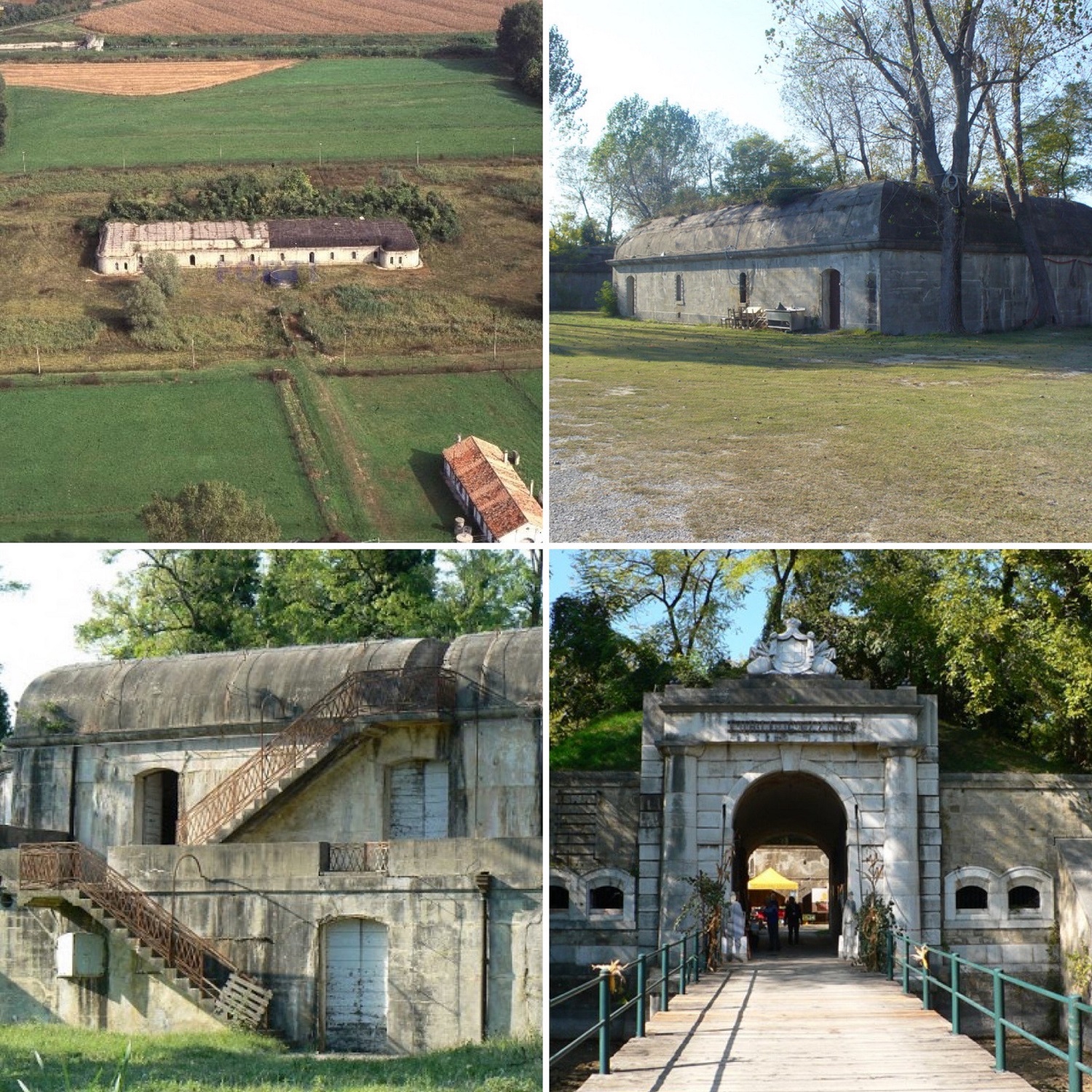The entrenched camp of Mestre was, in a not too distant time, a sophisticated defensive system for Venice and its territory with its complex system of fortified structures. The work was carried out between the 19th and the early 20th century, during a crucial historical moment that goes through the period of French and Austrian occupation, until the constitution of the Kingdom of Italy.
Today the forts of Mestre are a precious historical testimony for the local population and not only: it is, in fact, one of the four European entrenched camps (together with those of Paris, Bucharest and Rome) still existing and undoubtedly the one currently best preserved.
The visit to the forts of Mestre is interesting, however, not only from a historical point of view, but also from an architectural and naturalistic point of view. A truly unique experience, which can be put on the list of things to do beyond the Ponte della Libertà.
The forts can be divided into two groups, according to the period of construction: there are in fact those built in the nineteenth century and those of the second generation, built in the early twentieth century, for a total of 12 buildings, fortunately still present in the area and partly visitable.
The oldest group includes Forte Marghera, Forte Manin, Forte Tron, Forte Gazzera and Forte Carpenedo. The group of second generation forts consists of Forte Poerio, Forte Sirtori, Forte Mezzacapo, Forte Cosenz, Forte Rossarol, Forte Pepe, Forte Bazzera.
Not being able to go through them all, we have chosen the significant ones, both from the historical and architectural point of view as well as from the naturalistic point of view, and those accessible to visitors today.
Forte Marghera: the oldest and largest Fort of the entrenched camp of Mestre

Built between '800 and early '900, the so-called entrenched camp of Mestre is composed of several defensive works that have as their pivot Forte Marghera, the oldest and largest of all, with its 48 hectares.
Overlooking the Lagoon of Venice, the Fort was built in the middle of the Napoleonic age: it was in fact 1806 when Napoleon Bonaparte decided to build a defence structure in this area.
The Fort, after the fall of Napoleon in 1814 and the return of Austrian domination, continued to have defensive functions until 1866, the year of the Third War of Independence and the annexation of Veneto to the Kingdom of Italy.
The choice of the area in which it stands was purely strategic: in fact, it allowed to keep Fusina and Campalto under control, two places from which possible threats could arise.
Its plan is star-shaped, a detail that allows the fort to present itself on three concentric defence lines, separated by artificial ditches filled with the waters of the Canal Salso.
To better understand its structure, we rely on the words of Luigi Arvali, contained in the book "Forte Marghera"(2007):
"The inner wall is given by the development of a polygonal line of pentagon-shaped ramparts with a smaller side 100 metres long facing Mestre, the two adjacent to it of two hundred and forty metres each and the others facing the lagoon, both two hundred metres long. The latter two at the junction point are interrupted by the Military Canal, so that a part remains isolated, creating an independent bastion which was identified with the name of Lunetta X".
A project conceived as suitable to make effective the ball projectiles launched by smooth-barrelled artillery. This, however, only until the new ogival projectile artillery with a greater range took hold. It was then that Forte Marghera lost its tactical function, which it had until then, to assume a purely logistical function.
Given the conversion of use, buildings were built inside it suitable to house offices, warehouses and laboratories: the first Fort of the territory became during the twentieth century a real citadel and until 1995 it remained a military garrison.
Since 2010 Forte Marghera has been owned by the City of Venice, which has long used it to host cultural events. In recent years, for example, the Biennale di Venezia has been granted some spaces for exhibitions during art or architecture events.
A part of the facilities is instead under management for some time now to a cooperative that has used closed and open spaces as dining areas that, especially in summer, have become a meeting place for Mestrini, Venetians and tourists.
Forte Carpenedo: un luogo tra storia e natura a un passo dalla città

Forte Carpenedo is located further away from the Lagoon than Forte Marghera, which overlooks it.
The area in which it stands was part of the ancient Valdemar woods, whose origins date back as far as 3000 years ago: a very extensive wooded area that over time was given to the inhabitants and used by the Serenissima for the construction of boats.
What remained of this ancient forest disappears with the construction of this Fortress, whose birth is attested between 1887 and 1890.
Built on the model of the forts designed by the Austrian Colonel A. Tunkler, also called Prussian type, Forte Carpenedo is one of the most interesting from a naturalistic point of view for the flora and fauna that characterize it.
The structure has a hexagonal shape and is surrounded by a moat fed by resurgence. The idea behind the construction of the Fort was that it appeared from afar as a rise from the ground, practically imperceptible and without high trunk vegetation. Access is possible thanks to a bridge, at the time a drawbridge.
Here history, architecture and nature are perfectly integrated to the point that visitors experience the sensation of accessing a different space-time dimension, perhaps because somehow perceived as suspended.
Crossing the bridge it is possible to see the beautiful portal in neoclassical style, decorated with the Savoy insignia and the four caponiere where the machine guns were positioned to keep the moat in sight. From here it is possible to access to the central body (crossbar) where there are the premises of the logistics and then the command, the service rooms, the infirmary, the tailoring, the offices, the odrerly room.
Usually on the first Sunday of the month the Fort is open to the public, thanks to a local association of volunteers that for years has been committed to the conservation, maintenance and enhancement of the structure. It is therefore interesting to enter the rooms where furniture, equipment and clothes of the time are still kept. In this way it is possible to immerse oneself and better identify oneself in this place, understanding the very dynamics of life at that time.
The destiny of this Fort is not different from that of Forte Marghera: in fact, at a certain point it too undergoes a transformation, becoming a powder keg and seeing the existing structures modified accordingly and making it necessary to build new ones.
As we said, Forte Carpenedo is particularly interesting from a naturalistic point of view because it has some really unique and valuable characteristics. It seems paradoxical, but even though it rose from the destruction of what remained of the ancient Valdemar woods, today it is considered an oasis to be safeguarded, because it is rare for its location, not so far from the concrete and the city smog.
Walking for example along the path that develops along the perimeter of the area of Forte Carpenedo it is possible to make unexpected encounters with different types of fauna species. Also interesting is the rich and varied meadow vegetation and the area surrounding the fort which has a tree species such as oak, as well as groups of shrubs typical of the edge of woodland or undergrowth. Particular also the aquatic and marshy flora with the development of reeds thanks to wet meadows, because they are subject to flooding. Among the plant species near the strip in contact with the water of the ditch are therefore the elder, a plant that grows in difficult conditions, and the brambles.
Today, in addition to guided tours, which are possible at certain times of the year, the fort is open almost every day in the part before the entrance portal, thanks to a bar-restaurant that guarantees entry, although limited to those who, perhaps on a bicycle route, want to stop for a break and take a short trip through time.
The other Forts: a path full of discoveries

As said at the beginning, the forts are numerous and even if there are few accessible ones inside them, it is possible to understand their conformation and location in the territory.
Among these we remember Forte Cosenz which is located in an area adjacent to the part of Wood of Mestre recovered, between Favaro Veneto and Dese. A place that still exudes a certain charm today, even if in a state of decay and not accessible. Built in 1911, this Fort was built mainly with a precise function: to defend the railway line to Trieste that passes next to it.
Its twin is Forte Sirtori, built in the same year, but near Via Miranese, also in Mestre. As for the other forts, its structure is in concrete with the function of protecting the positions from the shooting of medium calibre cannons. Its function was to control the railway lines to and from Valsugana and the city of Padua.
Not too far away is Forte Rossarol in Tessera. Built in 1907, originally this must have been the most important fort in the entrenched camp of Mestre due to its strategic position. Its structure distinguishes itself from all buildings of the same type erected at the beginning of the twentieth century: developed on two floors, with a height of about nine meters, it has a particular aspect due to the four wells with machine guns that emerged in the middle of the front embankment.
Forte Gazzera is the oldest of the Tunkler model forts, built in 1883, and extends for about 13 hectares. Between the Marzenego and Dosa rivers, the fort is bounded externally by high earthen embankments that make it not very evident from the outside and surrounded by a large moat. The only access consists of a pier, guarded by a guardhouse on the side of the access road. At the other end there is a drawbridge that leads to the entrance and is defended on the sides by two pairs of slits.
During the Second World War the Forts were used as a powder keg. The warehouses (lined with oak) were filled with ammunition, hand grenades, TNT and other weapons of war.
On April 30, 1945, after the abandonment of the retreating Germans, the entrenched camp of Mestre passed to the British who continued to use it as a powder magazine until the end of the war.
At the end of the war, for about forty years the Forts continued to be used as a deposit until gradually they were put into disuse and demilitarized. Given the high costs of maintenance, these structures were left by the military who by then used them only as a deposit of inert materials.
Fortunately, as in the case of Forte Marghera and Forte Carpenedo, now owned by the municipality, there were people, gathered in associations, who had the will and courage to safeguard this important testimony of the town's history. Therefore they decided to reconvert once again this kind of structures, showing that remembering the local history can also happen through social and cultural aggregation initiatives. And it is fundamental to remember the past to build a good future!










Lascia un commento